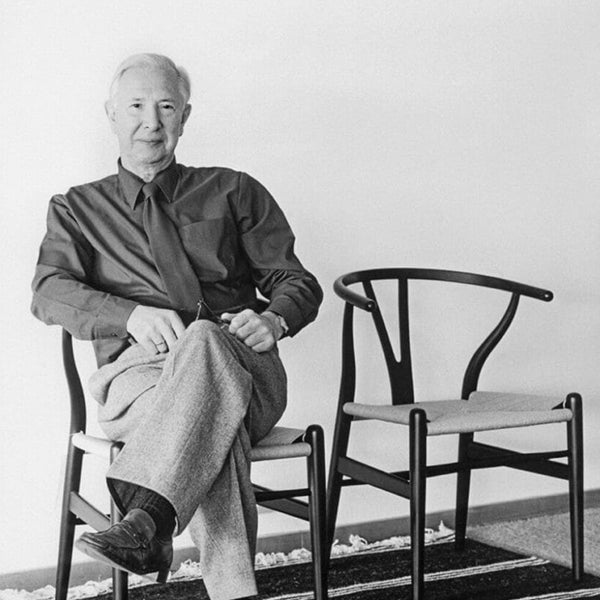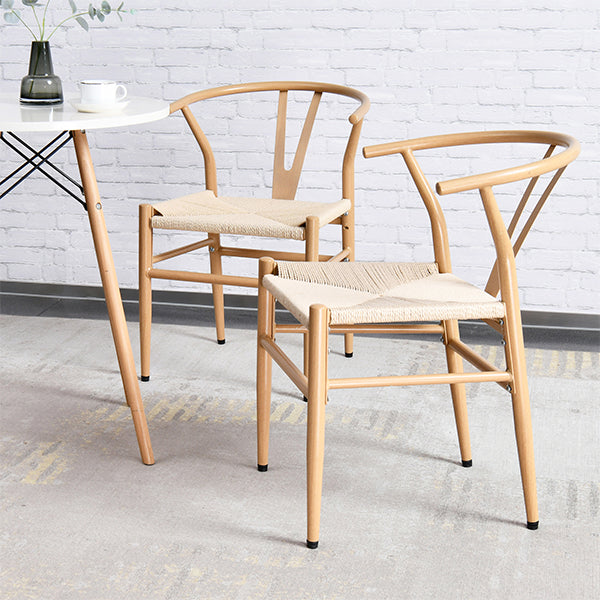The True Story Behind Iconic Wishbone Style Chair Design

Duhome Furniture .
Aug 04, 2023
Have you ever spotted a uniquely shaped chair with an ox horn-like bent back in someone's home or restaurant? One with a swooping, sculptural frame that looks equal parts artful and ergonomic? If so, you've likely caught a glimpse of the interior iconic wishbone chair, a mid-century modern masterpiece that has captivated design lovers for over 70 years.
The Ming style, deeply influenced by the philosophies of Taoism and Confucianism, birthed shapes defined by a continuous horizon of lines converging in chair backs and curved arms—an expression known in China as "yuanhun"—symbolizing power and good fortune. While various European furniture makers, including Kaare Klint, the pioneer of Danish Modernism, emulated the Ming style, Wegner's approach was unique. He seamlessly melded the Ming aesthetic with a Scandinavian sensibility, thus birthing a style often referred to as "organic functionality".
The result was the wishbone Y chair, named after its signature wishbone-shaped backrest. This sculptural continuous piece of wood supports the sitter's back and eliminates the need for cumbersome separate armrests. Perched upon the wooden frame is an artfully woven seat made of durable yet pliable paper cord, offering both support and texture.

When Hans Wegner first dreamed up the wishbone chair, comfort was his number one priority. To create a harmonious, ergonomic shape, he cleverly incorporated the backrest and armrest into a single swooping piece. This curved form cradles your back without digging in. The gently bent wood feels natural, while the forgiving paper cord seat adds a cozy touch.
For over 70 years, the Danish wishbone weave chair has built a solid reputation for reliability and comfort. Whether you're nestling into the kitchen table or dining room, its comfort factor remains unmatched. The wishbone chair offers a perfect blend of midcentury style and ergonomic support.
While its slender legs and bent back rails exude grace, the wishbone style chair doesn't sacrifice coziness for looks. The curved back provides just enough give to keep you relaxed through lingering dinners and conversations. No wonder this icon has been an in-demand classic for decades. With its harmonious form and ingenious comfort, the wishbone weave chair brings together the best of both beauty and ergonomic design.

However, deeply colored liquids like wine or juice can still seep into the fibers. Blot up any spills immediately with a damp cloth, patting gently to lift the stain rather than rubbing it in. The paper cord is naturally stain resistant, but beware of prolonged exposure.
If discoloration occurs, summon your inner arts and crafts master. The seat can be repaired or replaced by a skilled weaver, restoring your wishbone chair to its original glory. With a bit of care, the chair's comfortable, cool paper cord can last for years of family meals and conversations. Keep harsh detergents away and handle with care, and this woven seat will hold up to life's little messes. A simple cleaning routine lets your wishbone Y chair's iconic design shine.
What is a Wishbone Chair?
What style is a wishbone chair? Woven wishbone chairs may seem ubiquitous today, but their origin story begins over 70 years ago with a captivating photograph. In the early 1940s, Danish designer Hans J. Wegner stumbled upon images of Chinese Ming Dynasty-era chairs and was mesmerized by their shapely seats. This sparked in Wegner a years-long obsession to create his own graceful, swooping seat - one that would ultimately become one of the most iconic chairs of the 20th century. It's no wonder that you can find the wishbone chair in many modern homes, restaurants, and hotels around the world.Who Designed the Wishbone Style Chair?
In 1947, amid the aftershocks of World War II, a young and then relatively unknown Danish designer named Hans Wegner introduced the world to the mid century wishbone chair at the Copenhagen Cabinetmakers’ Guild Exhibition. What inspired Wegner's creation was not a fleeting trend of the time, but the enduring Ming Dynasty of China. Specifically, he found inspiration in portraits of Danish merchants seated in Chinese Ming Chairs.The Ming style, deeply influenced by the philosophies of Taoism and Confucianism, birthed shapes defined by a continuous horizon of lines converging in chair backs and curved arms—an expression known in China as "yuanhun"—symbolizing power and good fortune. While various European furniture makers, including Kaare Klint, the pioneer of Danish Modernism, emulated the Ming style, Wegner's approach was unique. He seamlessly melded the Ming aesthetic with a Scandinavian sensibility, thus birthing a style often referred to as "organic functionality".
The result was the wishbone Y chair, named after its signature wishbone-shaped backrest. This sculptural continuous piece of wood supports the sitter's back and eliminates the need for cumbersome separate armrests. Perched upon the wooden frame is an artfully woven seat made of durable yet pliable paper cord, offering both support and texture.
Wishbone Chair designed by Hans J. Wegner
Are Wishbone Back Chair Comfortable?
One might ask: "Is the wishbone chair comfortable or is it good for back?" Those who have had the pleasure of sinking into one of these chairs can attest to the comfort. With its distinctive curved backrest, the wishbone Y chair may not look like the most comfortable seat. But its clever design ensures you can sit back and relax in style.When Hans Wegner first dreamed up the wishbone chair, comfort was his number one priority. To create a harmonious, ergonomic shape, he cleverly incorporated the backrest and armrest into a single swooping piece. This curved form cradles your back without digging in. The gently bent wood feels natural, while the forgiving paper cord seat adds a cozy touch.
For over 70 years, the Danish wishbone weave chair has built a solid reputation for reliability and comfort. Whether you're nestling into the kitchen table or dining room, its comfort factor remains unmatched. The wishbone chair offers a perfect blend of midcentury style and ergonomic support.
While its slender legs and bent back rails exude grace, the wishbone style chair doesn't sacrifice coziness for looks. The curved back provides just enough give to keep you relaxed through lingering dinners and conversations. No wonder this icon has been an in-demand classic for decades. With its harmonious form and ingenious comfort, the wishbone weave chair brings together the best of both beauty and ergonomic design.

How to Clean Wishbone Chair Seat?
Uh oh, spill on your wishbone chair's iconic seat? Don't panic. The Danish wishbone chair is not just a beauty to behold and a delight to sit on; it's also relatively easy to maintain. Keep that woven seat looking fresh with just a few simple cleaning tips. For day-to-day upkeep, occasionally wipe the durable paper cord with a soft cloth dampened in mild, colorless soap. But be gentle - too much scrubbing can wear down the material over time. The seat's thin wax coating helps repel minor stains.However, deeply colored liquids like wine or juice can still seep into the fibers. Blot up any spills immediately with a damp cloth, patting gently to lift the stain rather than rubbing it in. The paper cord is naturally stain resistant, but beware of prolonged exposure.
If discoloration occurs, summon your inner arts and crafts master. The seat can be repaired or replaced by a skilled weaver, restoring your wishbone chair to its original glory. With a bit of care, the chair's comfortable, cool paper cord can last for years of family meals and conversations. Keep harsh detergents away and handle with care, and this woven seat will hold up to life's little messes. A simple cleaning routine lets your wishbone Y chair's iconic design shine.
How to Tell Original Wishbone Chair?
How can you distinguish an original Hans Wegner chair from a replica? Well, it's all about inspection. Look for a seamless back/armrest made from a single piece of wood, smooth tapered legs, and an evenly woven paper cord seat. Genuine chairs bear a label with Carl Hansen's logo, Hans Wegner's signature, and possibly a model number under the seat. Authentic modern wishbone chairs incorporate a single solid piece of timber for the curved top rail, steam-bent to ensure no joins, and seats featuring curved and tapered dowels. In contrast, replicas often use synthetic cord or cheap nylons for the seat.To authenticate a real modern wishbone chair, check for these signs:
- One solid piece of curved timber for the back and armrests
- Tapered legs made from high-quality Danish oak, beech, ash or walnut
- Tightly and uniformly woven paper cord seat with narrow gaps
- Label underneath with Carl Hansen logo and Hans Wegner's signature
